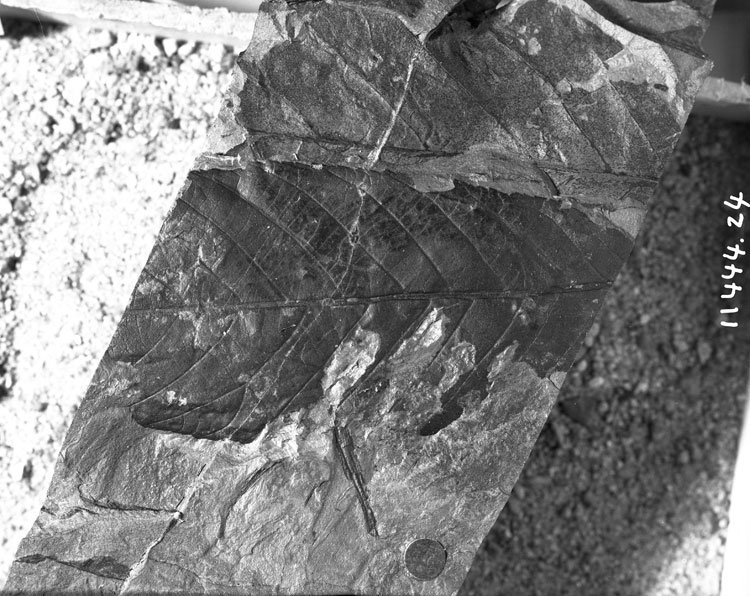Locality
Latitude: 56.268889° N
Longitude: -158.659722° W
Chignik (B-2) Quad.
Collected by R.A. Spicer and J.A. Wolfe.
Floodpain swamp. Lower part of Tolstoi Formation.
Description
Leaf: simple; symmetrical; oblanceolate or narrow obovate; apex obtuse; base missing; margin serrate, teeth apices obtuse to rounded, both apical and basal sides convex, sinuses angular acute, teeth more or less regular in size, shape, and spacing; venation pinnate, mixed craspedodromous, primary midvein moderate to stout, more or less straight; secondary veins arising at an angle of 60-70° without any noticeable change in angle along the length of the lamina, moderate gently uniformly curved, degree of curvature becoming more pronounced near the apical margin and joining the superadjacent secondary or a branch of it at an acute angle, branches of third order thickness given off from the secondary loop close to the margin and running to the apices of the teeth; tertiary veins percurrent, often forked, convex between primary and secondary veins but otherwise more or less straight, convex or sinuous, joining both ad- and abmedial sides of the secondary veins at an angle of 90° in the more basal parts of the lamina, becoming arranged almost perpendicular to the midvein and forming an acute angle with the abmedial side and an obtuse angle with the admedial side of the secondary in the more apical quarter of the lamina; fourth order veins percurrent, arranged at approximately 90° to the tertiaries and more or less straight or percurrent.
Remarks
These leaves possess characters that are supposed to be similar to those of the extant genera Rhamnus Linnaeus and Juglans Linnaeus. Bell (1957) illustrates a number of specimens which he calls Rhamnites eminens Dawson. There appears to be considerable variation within his specimens but a few (Plate 46, Fig. 2; Plate 48, Fig. 3; Plate 50, Fig. 5) exhibit the tendency for the tertiary veins to become perpendicularly arranged with the midvein in the apical region of the lamina. Bell, however, doubts the accuracy of the allocation of these the Rhamnaceae and suggests they might belong to the Anonaceae (Bell, 1957, p. 63). Presumably one factor that Bell might have considered in this respect is the entire margin which is unusual in the Rhamnaceae. The Chignik area specimens, however, clearly possess a toothed margin and therefore cannot be considered equivalent to Bell's specimens. This illustrates the importance of obtaining portions of the margin when dealing with fossil leaf forms.
A fossil form in which both venation and margin characters agree with the Chignik area specimens is that illustrated by Bell (1949) and called 'Juglans' nigella Heer (p. 55; Plate 57, Fig. 5) from the Paleocene Ravenscrag Formation of Saskatchewan. Brown (1962), however, considered this specimen equivalent to 'Carya' antiquorum Newberry (p. 55-56). He admits difficulty in separating 'Carya' Nuttall and 'Juglans' and suggests his specimens and synonymized specimens may represent a mixture of 'Juglans', 'Carya' and other Juglandaceous genera. His illustrated specimens vary considerably in shape and size (Plate 17, Figs. 1-7; Plate 18, Fig. 4) and were all collected from Paleocene strata. Hollick (1936) also illustrated some specimens he called 'Juglans' nigella (Plate 3, Figs. 1-5) which are similar to the Chignik area specimens (particularly Plate 38, Fig. 3), but the specimens shown in Plate 38, Fig. 5, appears to differ from the others in having numerous intersecondary veins and perhaps should be considered apart. All the specimens came from the Tertiary of Alaska.
Wolfe (1966), in describing specimens from Seldovian Stage strata of the Cook Inlet, combined 'J.' nigella with other forms into Pterocarya nigella (Heer) Wolfe. Wolfe's illustrated specimen (Plate 3, Fig. 3) differs from the Chignik area specimens in only one respect; that is, it has a single series of marginal loops whereas the Chignik area specimens are clearly craspedodromous in the middle part of the lamina. Both the base and the apical regions have brochidodromous secondaries and semicraspedodromous tertiary veins running into the teeth. This difference may not be as great as it at first appears as there may be a close relationship between the two venation patterns. Although all the similar published forms are of Tertiary age the small difference in venation noted between Wolfe's material and that from the Chignik area may be explained as related to an age difference. This is, however, pure speculation.
